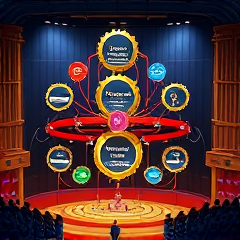Review of the book "Inbound Marketing" - Margarita Akulich. Methodology for implementing inbound sales
The author, like an experienced conductor, confidently leads the reader through the jungle of the digital ecosystem, showing how to turn cold traffic into hot leads using:
- Content
- SEO
- грамотной автоматизации (Competent automation)
However, despite the logical coherence and coverage of topics, at times it feels that Akulich is overly fascinated with HubSpot methodology - the question arises: where are the fresh insights grown on domestic soil?
Nevertheless, the book holds attention due to its practical content and specific solutions. This is material that is not just read, but actually applied in practice - and, as examples show, brings results.
Key Concepts and Their Analysis

What really distinguishes this study from other marketing drivel is the architecture of concepts, built with engineering precision: not just a set of terms, but a living organism, where each element - be it:
- behavioral segmentation,
- content funnel,
- multichannel interaction —
Each element is logically integrated into the overall system. The author is not limited to simple definitions, but reveals in detail the structure and interconnections of concepts, with analytical precision and clear argumentation.
The chapter that explains the difference between engagement and retention was particularly impressive: not through boring diagrams, but through the metaphor of a theater, where the viewer is not just watching a performance, but becomes its co-author. Such conceptual findings not only refresh perception - they make the marketer rethink their own approach.
However, in fairness, it is worth noting that sometimes the theoretical construction loses touch with reality: everything fits too smoothly on paper, where there are no bugs, failures, and human factors. There is a feeling that some sections are written for the ideal world of Excel, rather than for the bustling reality with its CRM bugs and the client's eternal "let's think about it some more".
And yet, despite these rough edges, the conceptual skeleton of the book is not a cardboard dummy, but a solid framework that can be relied upon in real practice.
Who is the book for
A reader who is familiar with the feeling of anxiety from a failed landing page or an endless cycle of unproductive leads, this guide will be like a marketing antidepressant. It's not for idle onlookers who dream of "trying out trends", but for those who daily juggle analytics, content, and KPI like a circus performer on the verge of a nervous breakdown. The book will be especially useful for those who are already fed up with template strategies and are looking not for another list of tactics, but for a coherent system that explains why some schemes work and others sink like a concrete ball.
- In it, both a beginner SMM specialist who is lost in a labyrinth of terms will find a haven,
- and a marketing director who wants to finally break free from outdated funnels.
But - and this is important - those who are looking for a magic "bring me a client in 5 minutes" button, are better off passing by: here you will have to think, test, make mistakes, and think again.
About the author and their significance in marketing

The surname Akulich on the cover is associated with a professional, structured approach to marketing. Its materials are practice-oriented and based on proven tools and data, rather than guesses or superficial observations.
- Aculich's approach is based not on general phrases, but on analytics, clear hypotheses, and data work. At the heart of her methodology is practical testing of solutions and structured planning.
- Aculich speaks as a practitioner with experience working with real tools, limited budgets, and multiple tests. Her conclusions are based on personal experience, where effectiveness is confirmed by results, not theory.
- Those who think that everything is already known in marketing should pay attention to Aculich's cases - these are not abstract theories, but practice-proven results based on hard work and analysis of mistakes.
Key ideas:
- Surgical precision strategies
- Practical experience and real cases
- Uncompromising analysis
The Place of the Book in Modern Marketing Literature
Against the backdrop of an endless stream of pseudo-scientific bestsellers, where loud headlines hide banalities, the publication cuts into memory like an icebreaker into a frozen bay - not elegantly, but thoroughly. In the modern pantheon of literature on sales and communications, it occupies not just a niche, but builds a whole fort of knowledge, where:
- each brick is a case study,
- each floor is a structure,
- the roof is sober analytics.
Unlike fashionable "gurus" who sell obvious truths packaged as "insights", there is no room for empty words here: everything is filtered through a real business lens. This is not another "how to become successful in 30 days", but a scalpel in skilled hands that can cut out inefficiency from any strategy.
Among modern publications on the topic, this is a rarity: the book doesn't flatter the reader, it challenges them. And that's exactly why it's memorable.
| Characteristic | Classic Books | This Book |
|---|---|---|
| Depth of Information | ||
| Practical Application | ||
| Practical Testing | ||
| Challenge to the Reader |
Relevance of the publication at the current moment

The book by Margarita Akulich remains relevant in the context of the modern digital economy and high competition. Traditional methods of attracting customers are losing their effectiveness, and inbound marketing focuses on useful content, personalization, and automation.
Today, consumers choose brands based on value and trust, which requires new approaches to sales. The author provides practical tools for building an effective inbound sales system based on data and analytics.
Given the widespread adoption of CRM and marketing technologies, the book is an important guide for professionals who want to adapt to modern realities and improve the effectiveness of their marketing campaigns.
Fundamental Marketing Concepts

At the center of this work is not an abstract pyramid of needs or the hackneyed 4P, but a living, breathing organism of the modern market, where the client is not just a "target audience," but an individual with anxious feedback and unpredictable click paths.
The author carefully and in detail analyzes familiar concepts:
- Value is not a slogan on a landing page, but a concrete answer to the question "why do I need this?"
- Positioning is not a beautiful wrapper, but armor that can withstand a barrage of competition in a niche.
The book is free of theoretical fluidity — every concept is strapped to reality like a seatbelt:
- A case study of a small business that overtook a giant due to a precise USP.
- Analysis of the behavior of a B2B client who now requires not ten, but twenty touchpoints, but with personal meaning in each.
This is not just a basis — it's a foundation driven into the cracking ground of 2025, where a marketer is not a philosopher, but an engineer.
Innovative ideas and modern trends
The author offers fresh and relevant ideas, demonstrating a deep understanding of modern trends in the digital economy. Her approach is free from outdated concepts like "forced funnel" or "cold outreach" - instead, she uses modern methods that already today require adaptation to platforms like TikTok and the specifics of audience behavior in the era of neural networks.
- Personalization: the author doesn't just talk about it - she shows how a single omnichannel scenario using behavioral analytics increased LTV in the online education niche in a short period.
While reading, you feel: it's not you exploring the book, but the book exploring you, breaking down familiar patterns and replacing them with something frighteningly new, yet thrillingly logical.
Relevance of concepts in modern business
The concepts outlined in Margarita Akulich's book are of high practical value for modern companies. In the conditions of a rapidly changing market and digital transformation, businesses need tools that allow them not just to attract customers, but to build long-term relationships with them.
The main methods - creating relevant content, segmenting the audience, and personalizing communications - help increase engagement and conversion, making marketing efforts more effective.
In addition, the approaches described in the book integrate well with modern CRM systems and marketing platforms, which facilitates the automation and scaling of processes. These concepts are especially useful for companies that build communications through several digital channels at once - from websites to messengers and email newsletters.
It clicks in your head: "You should have done it right away!" Practicality here is not a slogan, but the nerve of the system, and you suddenly realize that it's not just "can be used", but "impossible not to use" if you want to stay in the game.
| Aspect | Description |
|---|---|
| Relevance | High - meets the requirements of digital transformation and competition |
| Key methods | Content marketing, segmentation, personalization, omnichannel |
| Integration | Compatibility with CRM and marketing platforms |
| Scalability | Suitable for automation and expansion across different channels |
| Practical value | Not just "can be used", but "impossible not to use" |
Case studies and examples from real business
The book provides a number of practical case studies that demonstrate the effectiveness of inbound marketing in various fields. One striking example is the case of a company that successfully implemented a lead nurturing strategy, which significantly improved conversion rates and lead quality.
The author examines in detail how the use of CRM systems and marketing automation helps to optimize processes and increase the return on invested resources. The book also presents examples of adapting marketing strategies to different communication channels, including social media and email.
- Opened the letter — received a reminder
- Viewed the schedule — a specific class invitation popped up
When reading, it becomes clear: this is not a retelling of academic theories, but the result of practical work based on real experience and in-depth analysis.
Behind every chart is not dry analytics, but the living eyes of a marketer who manually recalculated ROI at night because the CRM report broke again.
This kind of example not only inspires — it causes an almost physical desire to open a laptop, dive into one's own funnel, and start redoing everything from scratch.
Strengths of the publication
It is in these dense, almost tangible pages that the main thoroughness of the work is manifested — the author doesn't just tell a story, but rather guides the reader by the hand through the minefield of real business, pointing out not only the shortest paths, but also those where she herself once stumbled.
The strongest aspect of the book is its practical embodiment:
- each tool is not just described, but implemented, tested, and returned to the pages with bruises, not fanfare.
Such details cannot be invented in the quiet of an office — they are the result of marketing with dirt under the nails, with Excel files where formulas get confused from overload.
Akulich knows not only how to show, but also how to infect with this obsession for details. After reading, the pages don't just turn — you feverishly search for something else to restructure in your own funnel.
Critical Analysis
However, behind this impressive precision and pragmatic grip lies an ambiguous residue — like after a perfect dish where the chef overdid it with the spices: the taste is bright, but the aftertaste is not for everyone.
In an effort to prove the effectiveness of each tool, the text sometimes turns into a multiplication table without the possibility of a breath — numbers, cases, diagrams, numbers again, and now you're not analyzing, but rather going through the motions.
- This is especially noticeable in the section on personalization — where a bit of philosophy would be welcome.
- The author dumps another block with UTM tags, responses by segment, and Power BI charts.
The question arises: is there room for intuition if everything is calculated to the seventh decimal point? In the pursuit of algorithms, the book sometimes loses its voice — the voice of a living expert, rather than a manual.
And it's here that you don't want to be led by the hand — you want to argue, doubt, go back, and rewrite it for yourself.
Tools and techniques for practical use
The author offers a clear and applied set of solutions focused on implementing inbound marketing in real business conditions. The book contains specific steps: from developing a content plan and setting up sales funnel logic to implementing automated lead interaction scenarios.
Practices are discussed in detail for working with CRM, email marketing, database segmentation, and behavioral metrics analysis. The author explains how to link marketing activity to measurable performance indicators and build processes that do not require constant manual control.
The approach is focused on reproducibility: each method can be adapted to different industries, regardless of the company's scale. This makes the book's content particularly valuable for those who want not just to understand how inbound marketing works, but to apply it in practice - without unnecessary theory and generalizations.
| Criterion | Approach | Effect |
|---|---|---|
| Clockwork mechanism | Cold calculation | Constant |
| Live communication | Emotional connection | Unpredictable |
Popularity of the real edition

Against this background, the fact that the book has gained steady authority among digital marketing specialists and has become a sought-after source for those who use modern approaches in promotion and sales is especially notable.
The popularity of the publication is also confirmed by its demand among companies seeking to adapt their processes to the current trends in digital marketing. The book has become a desk guide for those who are focused on results, rather than on template approaches.
It is in great demand in the B2B and B2C spheres, and its methods are actively used to increase conversion and build long-term relationships with customers.
Thus, the publication continues to remain an important and relevant tool in the field of marketing, maintaining high interest among professionals and entrepreneurs.
Other works by the author
Margarita Akulich is not only the author of the book "Inbound Marketing", but also a recognized expert in the field of digital marketing and sales. Her works cover a wide range of topics, including inbound marketing strategy, marketing automation, and customer behavior analytics.
One of her significant works is a guide to creating effective marketing funnels and tools for their optimization, which is popular among sales professionals. She also actively publishes articles, research, and case studies on topics such as improving conversion rates, implementing CRM systems, and adapting business processes to new digital realities.
Margarita actively shares her experience through webinars and training sessions, teaching both novice marketers and experienced professionals seeking to improve their results.
Comparison with other works by the author
At the moment, Margarita Akulich's main work in the field of inbound marketing is the book "Inbound Marketing". However, unlike her other materials and articles, this material represents a more in-depth and systematic guide to the implementation of inbound sales.
- It focuses on practical methods and tools that the author recommends using to build successful strategies in real business conditions.
Unlike her previous publications, which covered general principles of digital marketing and theoretical approaches, "Inbound Marketing" provides a more detailed guide to creating content strategies, marketing automation, and working with analytics.
Another difference is the style of presentation: while Akulich's earlier works are aimed at a wide range of readers, including beginners in the field of marketing, in this book the author is targeting a more experienced audience interested in implementing advanced marketing practices.
| Comparison criteria | "Inbound Marketing" | Previous works by Akulich |
|---|---|---|
| Depth of elaboration | Systematic and structured guide | General principles, overview materials |
| Focus | Practice of inbound sales, implementation of strategies | Theory of digital marketing |
| Toolkit | Specific techniques, automation, analytics | General description of marketing tools |
| Target audience | Experienced professionals, practitioners | Beginners, wide audience |
| Style of presentation | In-depth, applied | Popularizing, introductory |
Similar literature by other authors
Against this background, it is especially interesting to observe how on the shelves next to Akulich her ideological "neighbors" begin to line up — authors whose style is as if designed to compensate for her sterile rationality.
- Seth Godin with his "This is Marketing": his approach is jazz, improvisation, he doesn't build tunnels, he draws maps of the possible.
- Where Akulich offers a checklist with items and subheadings, Godin offers a metaphor, a paradox, a pinch of irony.
- Brian Halligan and Dharmesh Shah are the ones who stood at the origins of the idea about which Akulich writes with engineering pedantry.
- Their "Inbound Marketing" is not just a manifesto, but almost a love letter to the new ethics of communication: alive, pulsating, sometimes naive, but that's where its strength lies.
- Akulich against their background is like a cold architect building a building without windows, but with perfect ventilation: functional, but hard to breathe.
And that's why a reader tired of her normativity is involuntarily drawn to those who still believe that marketing is not just about funnels, but also about people.
